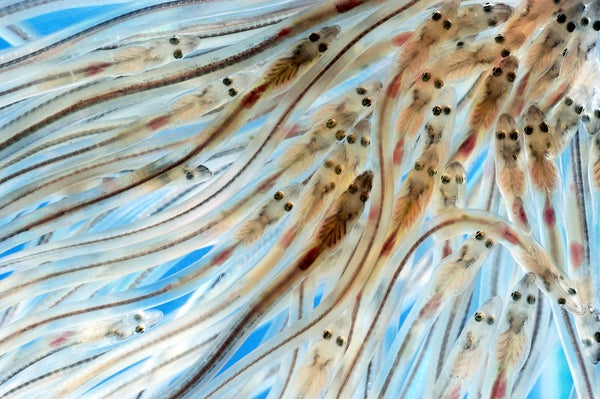More evidence has emerged to place European eels among other animals that use the Earth’s magnetic field to guide their migration, but the research methods used are causing controversy. A study published last week in Current Biology suggests eels generate a “magnetic map” of their surroundings that lets them read their location based on the field intensity, and use this map to find the Gulf Stream and catch a free ride to Europe. “We’re moving toward [magnetic sense] being the default hypothesis for how marine animals achieve their long-distance migrations,” says co-author Nathan Putman, a Florida-based biologist with the National Oceanic and Atmospheric Administration. “What was maybe viewed as an anomaly with sea turtles and salmon is now the hypothesis to beat.” Some scientists took issue with the study’s approach, however.
Eels migrate twice in their lifetime: once as four inch–long larvae from the Sargasso Sea to coastal waters and rivers of Europe and Northern Africa, and again after maturing for a decade or more, when they return to the Sargasso to spawn and die. Since the 1970s, researchers have suspected eels could sense magnetic fields, and a 2013 study proposed the animals used a “magnetic compass” to orient using the North Pole. The new study suggests the eels have a more complete command of their location and direction.
To test their hypothesis, researchers placed eels in a round, freshwater tank with 12 small chambers arranged like spokes around it, and a magnetic coil surrounding the whole apparatus. They simulated how it would have felt—magnetically speaking—for the eels to have been in four different locations along their larval migration route from the Sargasso to Europe. The eels chose which direction to swim by slithering over the barrier into one of the segments surrounding the central tank. Researchers tallied their choices and applied the data to a computer model of oceanic circulation. Based on the directions the eels would have gone in the Sargasso Sea, the researchers concluded the majority of the eels seemed to be swimming in the direction of what would have been the Gulf Stream from various points on their migration route.
On supporting science journalism
If you're enjoying this article, consider supporting our award-winning journalism by subscribing. By purchasing a subscription you are helping to ensure the future of impactful stories about the discoveries and ideas shaping our world today.
Some eel researchers have criticized the study because the authors didn’t use larval eels, but rather juveniles captured in in an estuary in the U.K., which had already completed their Europe-bound migration. “You could compare it to doing experiments on butterflies and expecting them to behave like caterpillars,” says Caroline Durif, a scientist at Norway’s Institute of Marine Research, who was not involved in the work but co-authored the 2013 study, which used adult eels captured as they started their return migration to the Sargasso Sea.
Other scientists point out the impracticality of attempting such a test on larval eels, however, because of the difficulty of capturing them. Michael Hansen, a biologist at Aarhus University in Denmark who was not involved in the study, agrees the age of the eels is the largest potential source of error, but says the results make sense biologically, which convinces him it was not a major issue. “It would be almost impossible to do a study like this on eel larvae,” he says, simply because tiny, transparent eels are tough to gather in large numbers in the open ocean. “I think it would be unrealistic to do it any other way than they did.”
Karin Limburg, a professor of environmental and forest biology at SUNY College of Environmental Science and Forestry who was also not involved in the work, agrees. The authors are “taking advantage of the fact that [with] eels, when they enter and colonize an estuary, you have a concentration of them,” she says. “If you were to try to sift through the Sargasso Sea for larval eels, you’d be out there till the cows come home. Odds of finding what you’re looking for are very low. I don’t see how they could have done it any other way.”
Putman defends his study on similar grounds. “We picked that life stage of eel because it was what we could get our hands on: eels that had just moved from ocean habitats into estuaries,” he says. He and his colleagues say they were posing a question to the eels: “‘If you felt displaced back into the North Atlantic, where would you feel like you should go?’ We got lucky that they still had some remnant of their migratory behavior.”
Durif also points out that simulating an oceanic migration in freshwater creates more potential for error. Putman argues that transferring eels caught in freshwater back to saltwater would add another variable to what was intended as a magnetic displacement test. “Only a change in the magnetic map conditions is necessary to elicit orientation responses from the eels,” he says.
